Seth Klarman stands out as a beacon of disciplined strategy and profound insight as an investor. Being the founder and portfolio manager of the Baupost Group, Klarman has earned his reputation as a deep value investing guru. His meticulous approach to finding undervalued assets has not only set him apart from his peers but has also made him a highly respected figure in financial circles. Klarman’s influence extends beyond his impressive track record; his thoughtful writings and prudent strategies continue to inspire both seasoned investors and newcomers alike.
source: The Swedish Investor on YouTube
Born in 1957, Klarman’s journey into the world of investing was shaped by his education at Harvard Business School, where he was deeply influenced by the principles of Benjamin Graham, the father of value investing. This foundational knowledge, coupled with his keen analytical skills, has enabled Klarman to navigate complex markets with confidence and precision. Under his leadership, the Baupost Group has grown into one of the most successful hedge funds, known for its ability to generate consistent returns even in volatile market conditions.
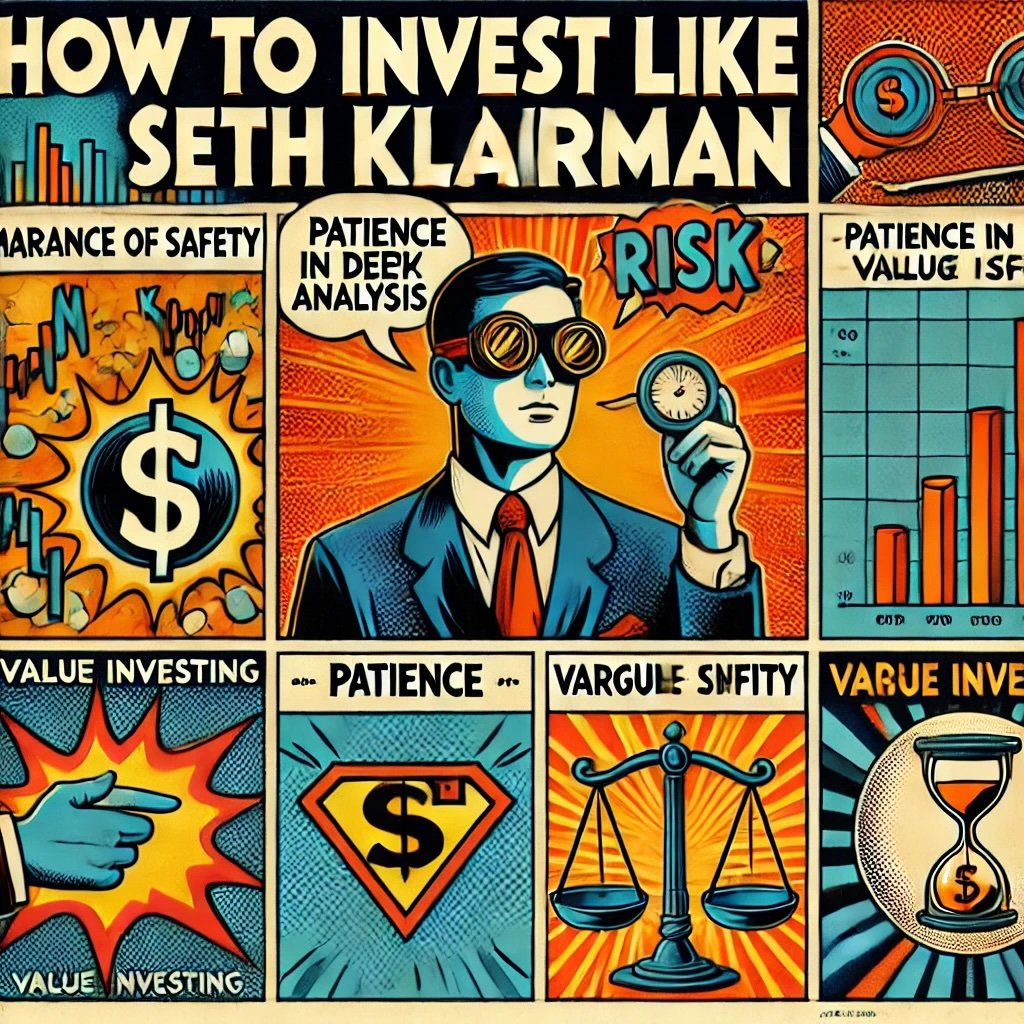
Meet Seth Klarman: The Deep Value Investing Maestro
So, why focus on Seth Klarman and his deep value investing strategy? The purpose of this article is to explore Klarman’s deep value investing strategy and demonstrate how you can apply his principles to enhance your own investment practices. Whether you’re a seasoned investor looking to refine your approach or a novice eager to learn the ropes, Klarman’s methodology offers valuable insights that can help you build a resilient and profitable portfolio.
By delving into Klarman’s investment philosophy, we aim to provide a comprehensive understanding of what makes his strategy unique and effective. From identifying undervalued assets to maintaining a strong margin of safety, Klarman’s approach is grounded in meticulous research and disciplined execution. This article will break down these concepts, offering practical steps and real-world examples to help you implement similar strategies in your own investing journey.

The Essence of Klarman’s Philosophy
At the heart of Seth Klarman’s investment philosophy lies a commitment to investing in undervalued assets with a strong margin of safety. But what does this mean in practical terms? Klarman’s strategy is built on the foundation of deep value investing, a disciplined approach that seeks to purchase securities at prices significantly below their intrinsic value. This not only provides a cushion against potential losses but also enhances the potential for substantial gains when the market recognizes the true worth of these assets.
Key Components of Klarman’s Philosophy:
- Undervalued Assets: Klarman searches for investments that the market has overlooked or undervalued, providing opportunities for significant upside.
- Margin of Safety: By buying assets well below their intrinsic value, Klarman ensures a buffer against errors in analysis or unforeseen market downturns.
- Rigorous Research: Every investment decision is backed by thorough analysis, including both quantitative metrics and qualitative assessments.
- Long-Term Perspective: Klarman emphasizes the importance of patience, allowing investments time to realize their full potential without being swayed by short-term market fluctuations.
Klarman emphasizes the importance of thorough due diligence and rigorous research. Before committing to any investment, he meticulously analyzes financial statements, assesses management quality, and evaluates the competitive landscape. This comprehensive evaluation ensures that each investment is not only undervalued but also possesses the fundamental qualities necessary for long-term success.
Tip for Best Practices: Embrace a disciplined approach to investing by conducting thorough research and maintaining a long-term perspective. Avoid the temptation to react impulsively to market fluctuations, and instead focus on the intrinsic value of your investments.
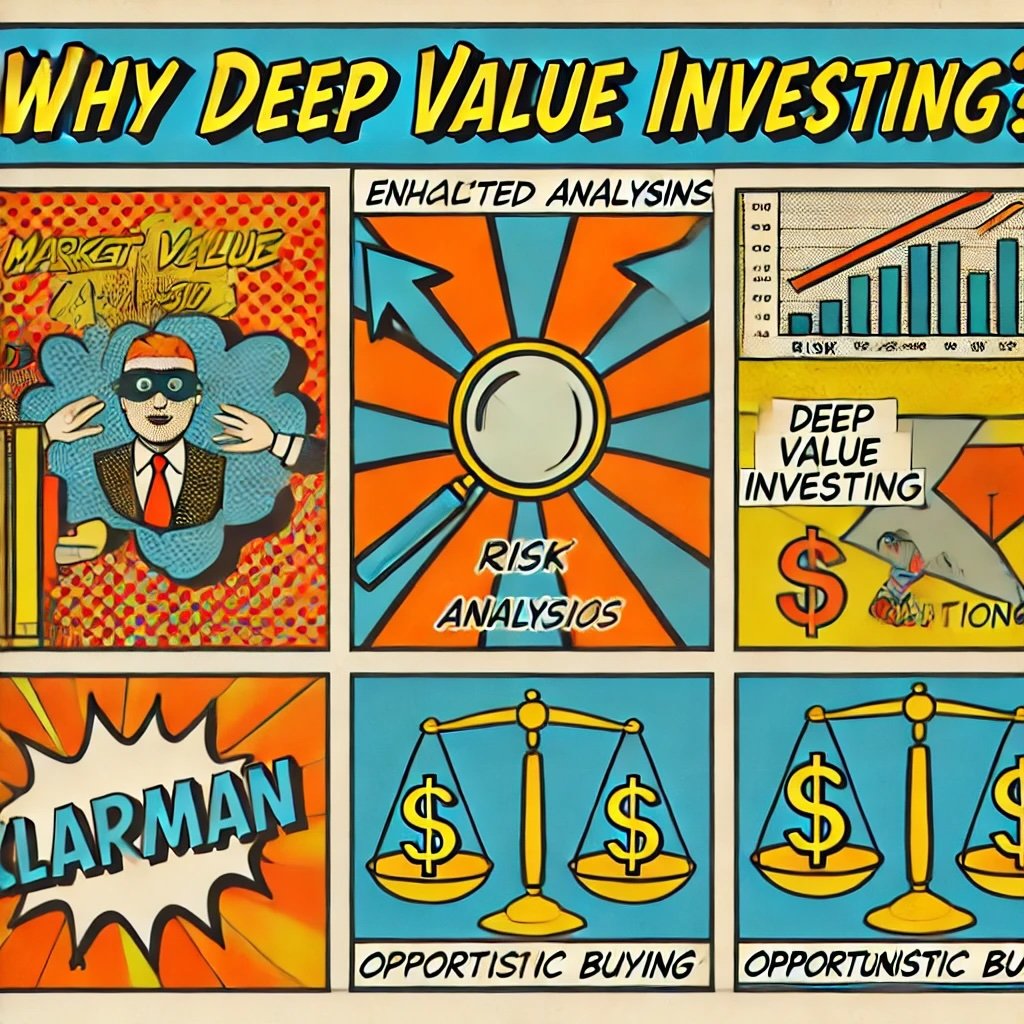
Why Deep Value Investing?
Deep value investing, as championed by Klarman, goes beyond traditional value investing. It involves identifying assets that are not just undervalued, but significantly mispriced by the market. This approach requires a keen eye for detail and a willingness to dig deep into the financials and operational aspects of potential investments. By focusing on deeply undervalued assets, Klarman aims to minimize downside risk while maximizing the potential for upside returns.
Benefits of Deep Value Investing:
- Enhanced Returns: Buying at substantial discounts increases the potential for higher returns as the market corrects the mispricing.
- Risk Mitigation: A strong margin of safety protects against potential losses, providing a buffer in uncertain market conditions.
- Opportunistic Buying: Deep value investing allows investors to capitalize on market inefficiencies and distressed opportunities that others may overlook.
This strategy is particularly effective in volatile or uncertain market conditions, where misinformation and panic can lead to significant mispricings. Klarman leverages these opportunities to acquire high-quality assets at bargain prices, positioning his portfolio for substantial growth as the market eventually corrects these inefficiencies.
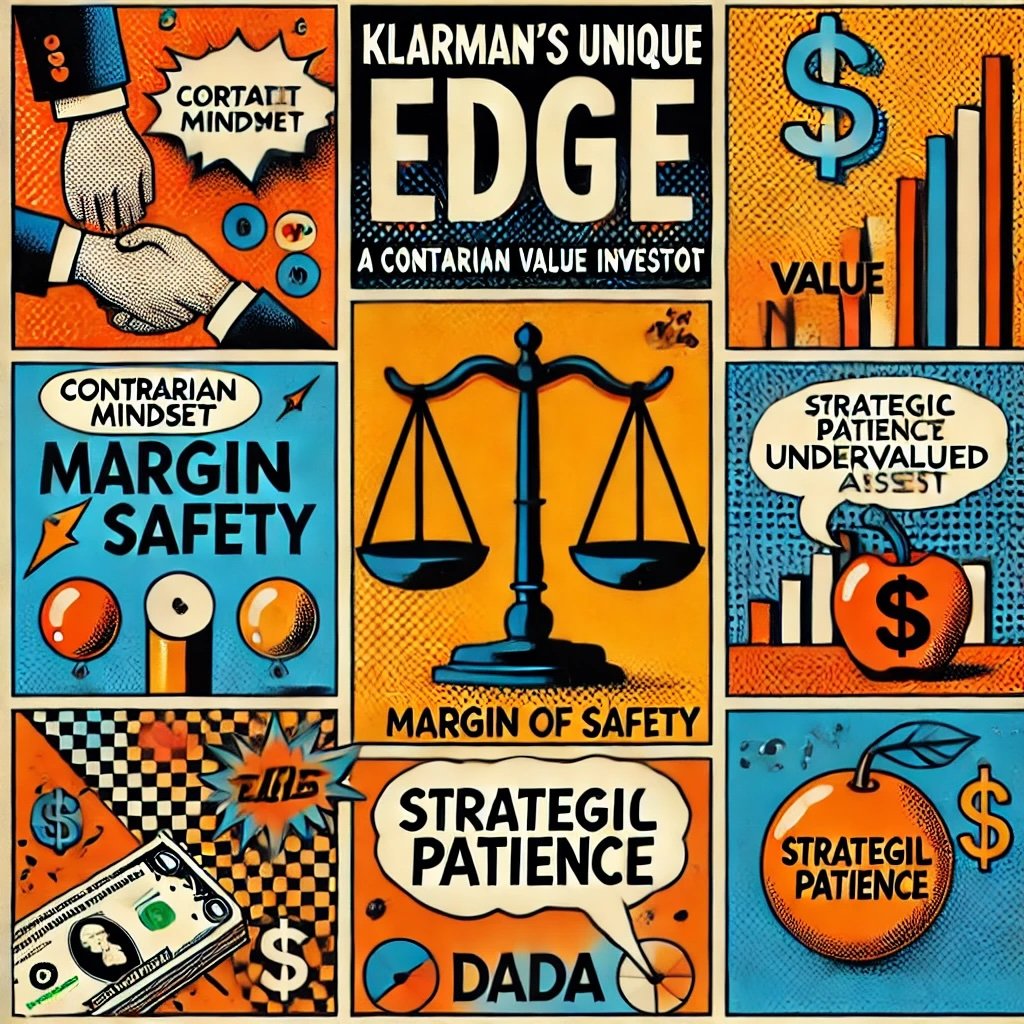
Klarman’s Unique Edge
What sets Seth Klarman apart from other value investors is his contrarian mindset and his ability to remain calm and rational in the face of market turmoil. While others may succumb to fear and sell off their holdings during downturns, Klarman sees these moments as opportunities to buy undervalued assets. His focus on a margin of safety ensures that even if the market doesn’t recognize the value of his investments immediately, there is a buffer to protect against potential losses.
Additionally, Klarman’s strategic use of cash reserves provides him with the flexibility to seize opportunities as they arise, without the pressure of needing to liquidate existing positions. This strategic patience is a cornerstone of his success, allowing him to make calculated moves that align with his long-term investment goals.
Bold Move: Adopt a contrarian approach by looking for opportunities in distressed or out-of-favor assets. When the market is fearful, it may be the perfect time to find hidden value.

The Concept of Deep Value Investing
What is Deep Value Investing?
When it comes to investment strategies, Deep Value Investing holds a special place for those who seek substantial discounts in the market. Unlike traditional value investing, which focuses on finding stocks undervalued by a modest margin, deep value investing digs even deeper. It targets assets that are significantly undervalued, often trading at a steep discount to their intrinsic value. This strategy is about uncovering hidden gems that the broader market has overlooked or mispriced, offering investors the potential for substantial returns once the market corrects these inefficiencies.
Key Elements of Deep Value Investing:
- Significant Discount: Identifying assets priced well below their intrinsic worth.
- Thorough Analysis: Conducting exhaustive research to understand the true value of an investment.
- Contrarian Approach: Investing in areas that are out of favor with the majority of investors.
- Patience: Holding investments long-term to allow the market to recognize their true value.
Deep value investing requires a meticulous approach. Investors must sift through extensive financial data, market conditions, and company fundamentals to find opportunities where the market has failed to recognize the true value of an asset. This often involves investing in distressed companies, turnaround situations, or industries undergoing temporary setbacks.
Tip for Best Practices: Focus on the fundamentals. Ensure that the discount is not a reflection of deeper, unresolved issues within the company that could impede its long-term success.

Margin of Safety: Protecting Against Downside Risk
At the heart of deep value investing lies the principle of the Margin of Safety. This concept, popularized by Benjamin Graham and embraced by Seth Klarman, involves purchasing assets at prices significantly below their calculated intrinsic value. The margin of safety acts as a buffer, protecting investors from errors in analysis or unexpected market downturns.
Why is Margin of Safety Crucial?
- Risk Mitigation: Provides a cushion against potential losses, ensuring that even if the investment doesn’t perform as expected, the downside is limited.
- Enhanced Returns: By buying at a discount, the potential for upside gains increases as the asset’s price moves closer to its intrinsic value.
- Emotional Comfort: Knowing there’s a safety net can help investors remain calm during market volatility, preventing panic-induced decisions.
Klarman meticulously calculates the intrinsic value of an asset, considering factors like earnings, growth prospects, and cash flow. He then seeks to buy the asset at a price that offers a comfortable margin below this intrinsic value. This disciplined approach ensures that investments are made with a safety net, reducing the overall risk while enhancing the potential for substantial returns.
Bold Move: Always incorporate a margin of safety in your investment decisions. It’s better to invest conservatively and protect your capital than to chase high returns with excessive risk.
Tip for Best Practices: Regularly reassess the intrinsic value of your investments and adjust your margin of safety as new information becomes available. This dynamic approach helps maintain the protective buffer over time.
Klarman’s Philosophy: Patience, Discipline, and a Long-Term Perspective
Seth Klarman’s success as a deep value investor is not just about finding undervalued assets; it’s also about embodying the virtues of patience, discipline, and a long-term perspective. These traits are essential in navigating the complexities and uncertainties of the market, allowing investors to stay focused on their investment goals despite short-term fluctuations.
Patience: Klarman understands that true value takes time to be recognized by the market. He is willing to hold investments for years, allowing the intrinsic value to be realized gradually. This patience prevents premature selling and capitalizes on the power of compounding returns over time.
Discipline: Maintaining a disciplined approach means sticking to your investment criteria and avoiding impulsive decisions driven by market hype or fear. Klarman’s disciplined methodology involves adhering to thorough research and not deviating from his investment principles, even when the market is volatile or sentiments are overwhelmingly negative.
Long-Term Perspective: By focusing on the long-term potential of his investments, Klarman avoids the pitfalls of short-term market noise. This perspective helps in making informed decisions based on the fundamental value of assets rather than transient market trends.
How Klarman Embodies These Principles:
- Consistent Strategy: Klarman follows a consistent investment strategy focused on deep value, regardless of market conditions.
- Emotional Control: He maintains emotional detachment from market movements, ensuring decisions are based on rational analysis rather than emotional reactions.
- Continuous Learning: Klarman stays informed and continuously refines his investment approach based on new insights and market developments.
Tip for Best Practices: Cultivate patience and discipline in your investment journey. Set clear long-term goals and resist the urge to make hasty decisions based on short-term market movements. Trust in your research and the intrinsic value of your investments.
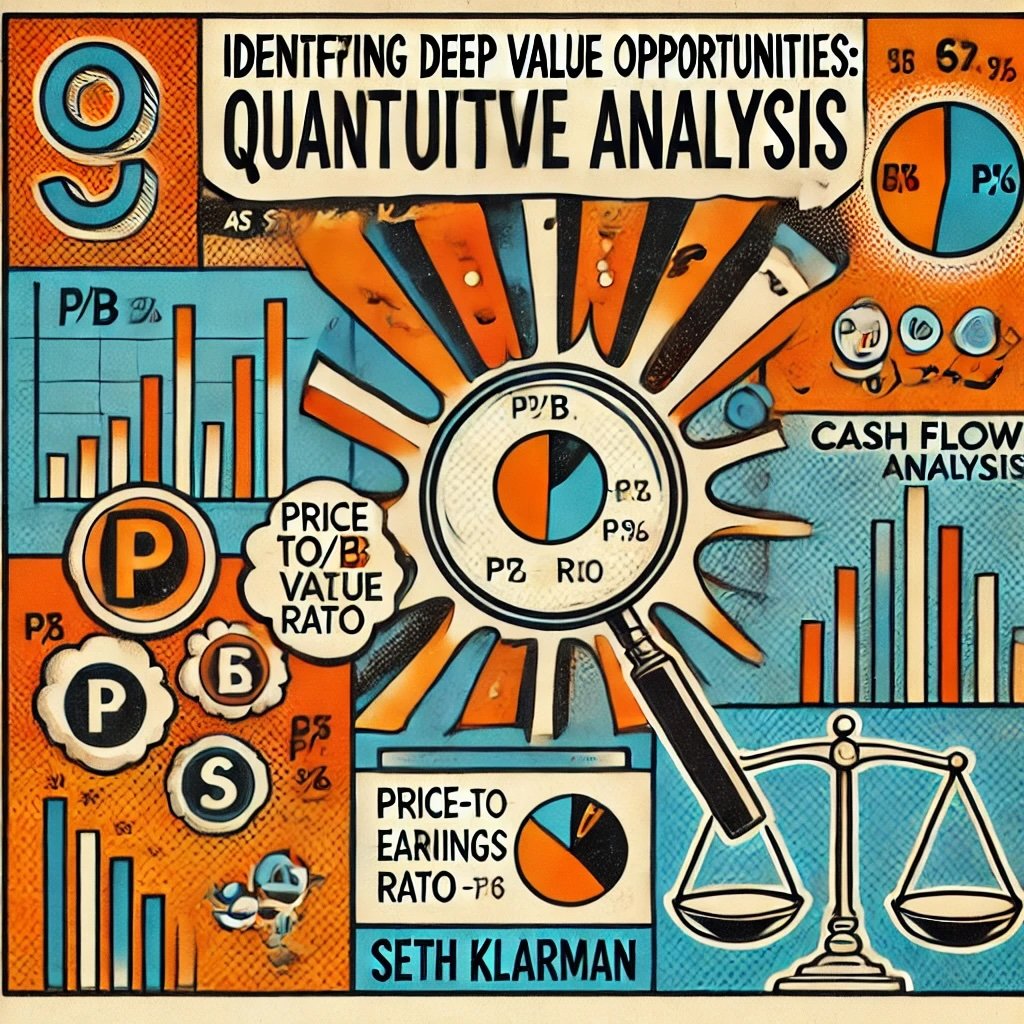
Identifying Deep Value Opportunities
Quantitative Analysis: The Numbers Behind the Value
Seth Klarman is renowned for his meticulous approach to identifying deep value opportunities. At the core of his strategy lies quantitative analysis, where he leverages key financial metrics to uncover undervalued stocks. This numerical scrutiny ensures that each investment decision is grounded in solid financial reasoning rather than market speculation.
Key Financial Metrics Klarman Uses:
- Price-to-Book (P/B) Ratio: This ratio compares a company’s market value to its book value. A P/B ratio below 1 indicates that the stock is potentially undervalued, as investors are paying less than the company’s net asset value.
- Example: If a company has a book value of $50 per share and is trading at $40, the P/B ratio is 0.8, suggesting an undervaluation.
- Price-to-Earnings (P/E) Ratio: This metric assesses a company’s current share price relative to its per-share earnings. A lower P/E ratio can signal that the stock is undervalued compared to its earnings potential.
- Example: A company with earnings of $5 per share trading at $30 has a P/E ratio of 6, which may be attractive compared to the industry average.
- cash Flow Analysis: Klarman places significant emphasis on a company’s cash flow, particularly free cash flow, which indicates the company’s ability to generate cash after accounting for capital expenditures. Strong cash flow is a sign of financial health and operational efficiency.
- Example: Consistent positive free cash flow over several years suggests that a company can sustain operations and invest in growth opportunities without relying heavily on external financing.
By focusing on these metrics, Klarman identifies companies that are not only undervalued but also possess the financial stability to weather economic downturns. This disciplined numerical approach minimizes risk and enhances the potential for long-term gains.
Tip for Best Practices: Utilize financial screening tools to filter stocks based on key metrics like P/B ratio, P/E ratio, and free cash flow. This can help streamline your search for undervalued opportunities that meet your investment criteria.
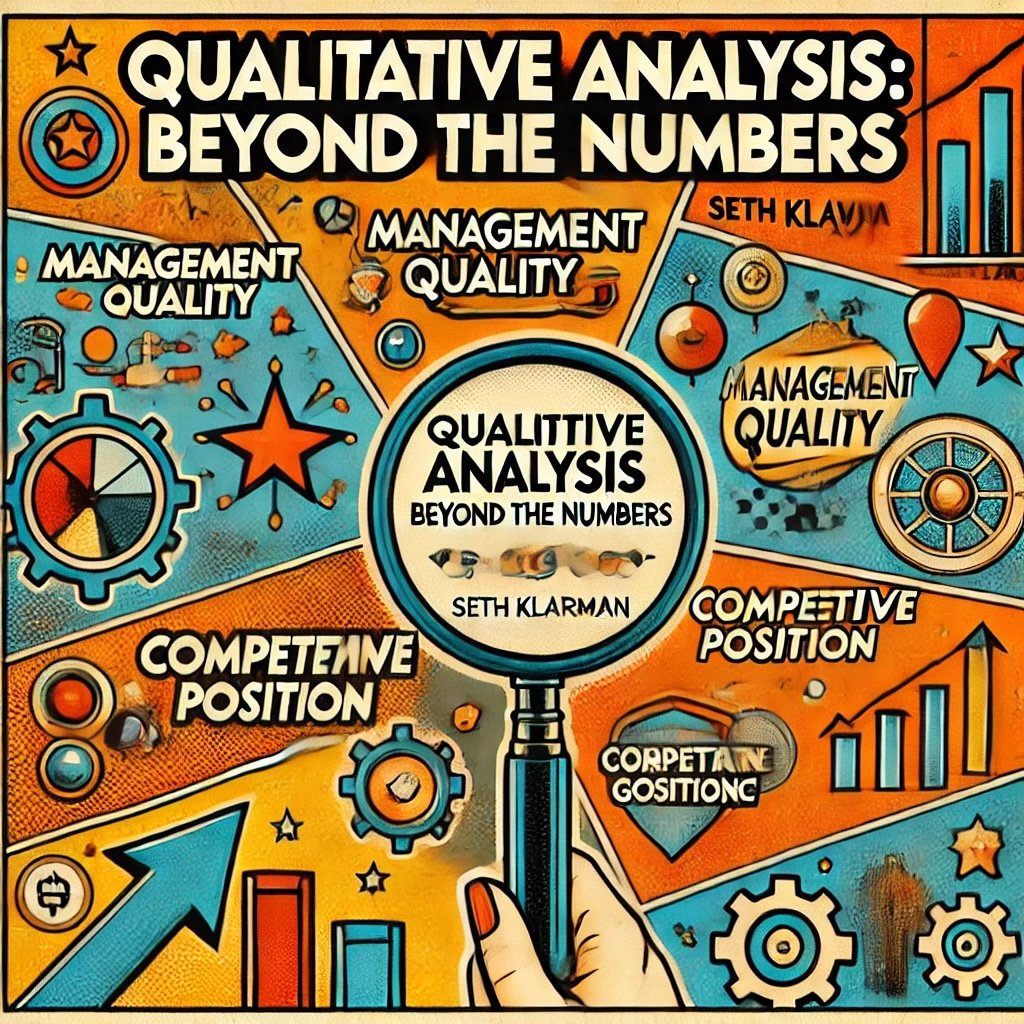
Qualitative Analysis: Beyond the Numbers
While quantitative metrics provide a solid foundation, qualitative analysis is equally crucial in Seth Klarman’s deep value investing strategy. This involves evaluating the non-numerical aspects of a company to gain a comprehensive understanding of its true value and long-term potential.
Key Areas of Qualitative Analysis:
- Management Quality: Klarman believes that strong, ethical, and visionary management is vital for a company’s success. He assesses the track record of the leadership team, their strategic vision, and their ability to execute plans effectively.
- Example: A CEO with a history of turning around struggling companies demonstrates the capability to navigate challenges and drive growth.
- Business Model: Understanding how a company makes money is fundamental. Klarman evaluates the sustainability and scalability of the business model, ensuring that it can adapt to changing market conditions and consumer demands.
- Example: A company with a diversified revenue stream across multiple sectors is better positioned to withstand industry-specific downturns.
- Competitive Position: Klarman examines a company’s position within its industry, looking for sustainable competitive advantages such as patents, strong brand recognition, or unique technology that set it apart from competitors.
- Example: A firm with proprietary technology that is difficult for competitors to replicate holds a significant edge in the market.
- Corporate Governance: Good governance practices are essential for ensuring that a company operates transparently and ethically. Klarman looks for companies with strong governance structures, including independent boards and clear accountability mechanisms.
- Example: A company that regularly communicates with shareholders and adheres to high ethical standards is more likely to maintain investor trust and long-term stability.
By integrating qualitative analysis with quantitative metrics, Klarman ensures that his investments are not only undervalued on paper but also fundamentally strong and well-managed. This holistic approach reduces the risk of investing in companies that may appear attractive numerically but lack the essential qualities for sustained success.
Bold Move: Don’t overlook the human element in your investment analysis. Assessing management quality and business sustainability can provide deeper insights into a company’s long-term viability.
Tip for Best Practices: Supplement your financial analysis with thorough research into the company’s leadership, business model, and industry position. Reading annual reports, listening to earnings calls, and following industry news can enhance your qualitative assessment.
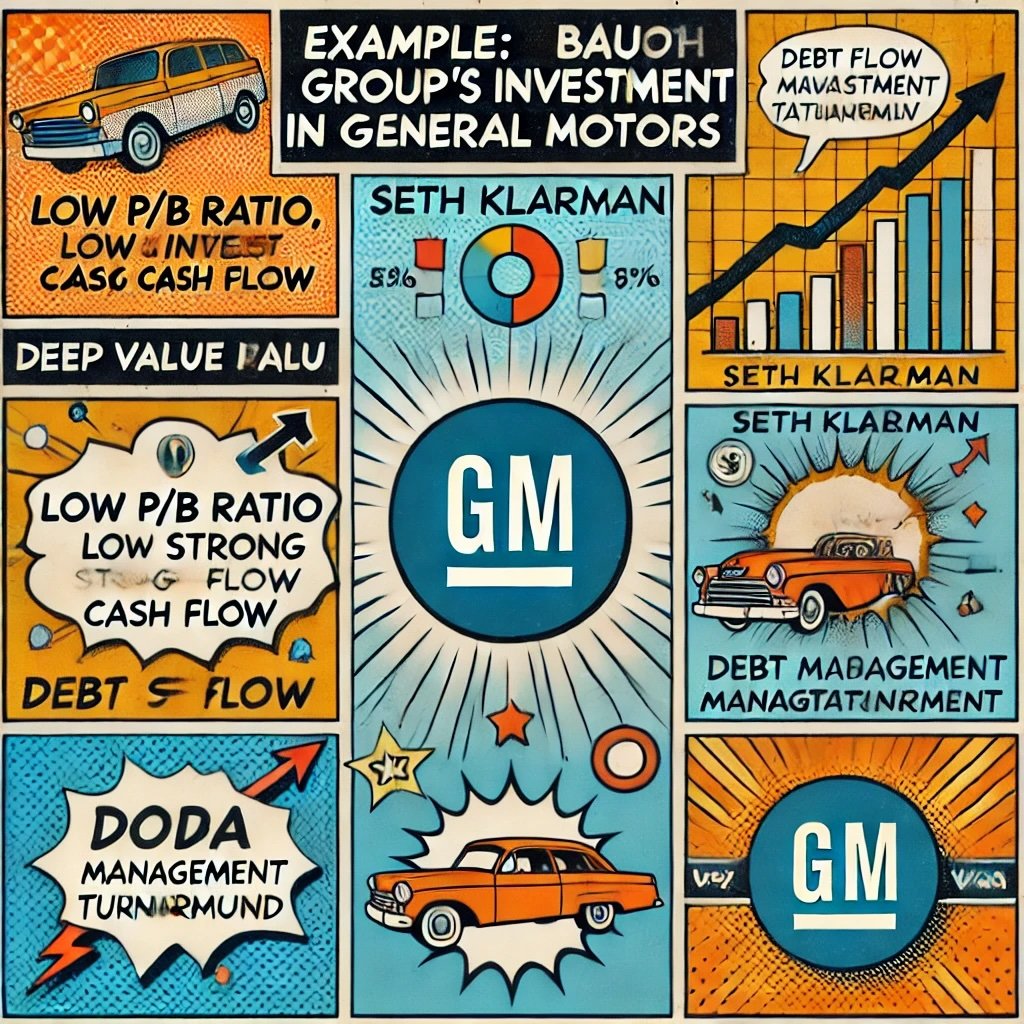
Example: Baupost Group’s Investment in General Motors
To illustrate Seth Klarman’s deep value investing approach, let’s examine a case study of the Baupost Group’s investment in General Motors (GM) during a period when the automotive industry was struggling.
The Context:
In the early 2000s, General Motors was grappling with declining sales, high debt levels, and intense competition from foreign automakers. The market sentiment towards GM was overwhelmingly negative, and the stock was trading at a significant discount to its intrinsic value.
Klarman’s Analysis:
- Quantitative Factors:
- Low P/B Ratio: GM’s stock was trading below its book value, indicating potential undervaluation.
- Strong Cash Flow: Despite operational challenges, GM maintained positive free cash flow, showcasing its ability to generate cash even in tough times.
- Debt Management: Klarman noted that GM had a manageable debt load relative to its assets, reducing financial risk.
- Qualitative Factors:
- Management Turnaround: Klarman observed that GM’s new management team was committed to restructuring and improving operational efficiency.
- Competitive Position: GM still held a substantial market share in key segments and had a strong brand presence.
- Resilient Business Model: The company’s diversified product lineup and global footprint provided a foundation for recovery.
The Decision:
Based on his comprehensive analysis, Klarman concluded that GM was significantly undervalued and poised for a turnaround. He believed that the company’s fundamentals were strong enough to withstand the industry challenges and that the market would eventually recognize GM’s intrinsic value.
The Outcome:
Over the next few years, GM successfully implemented its restructuring plans, reduced debt, and regained market competitiveness. As the company stabilized and began to grow, GM’s stock price appreciated substantially, rewarding Baupost Group’s early investment and reinforcing the effectiveness of Klarman’s deep value strategy.
Lessons from the Case Study:
- Thorough Analysis Pays Off: Klarman’s detailed evaluation of both quantitative and qualitative factors enabled him to identify a high-potential investment.
- Contrarian Investing: By investing in a company that was out of favor, Klarman capitalized on market inefficiencies and secured substantial returns.
- Patience and Discipline: Holding the investment through GM’s turnaround demonstrated the importance of a long-term perspective and steadfastness in one’s investment thesis.
Tip for Best Practices: Look for opportunities where thorough research reveals hidden value, especially in companies undergoing challenges that can be effectively managed or overcome with strategic changes.
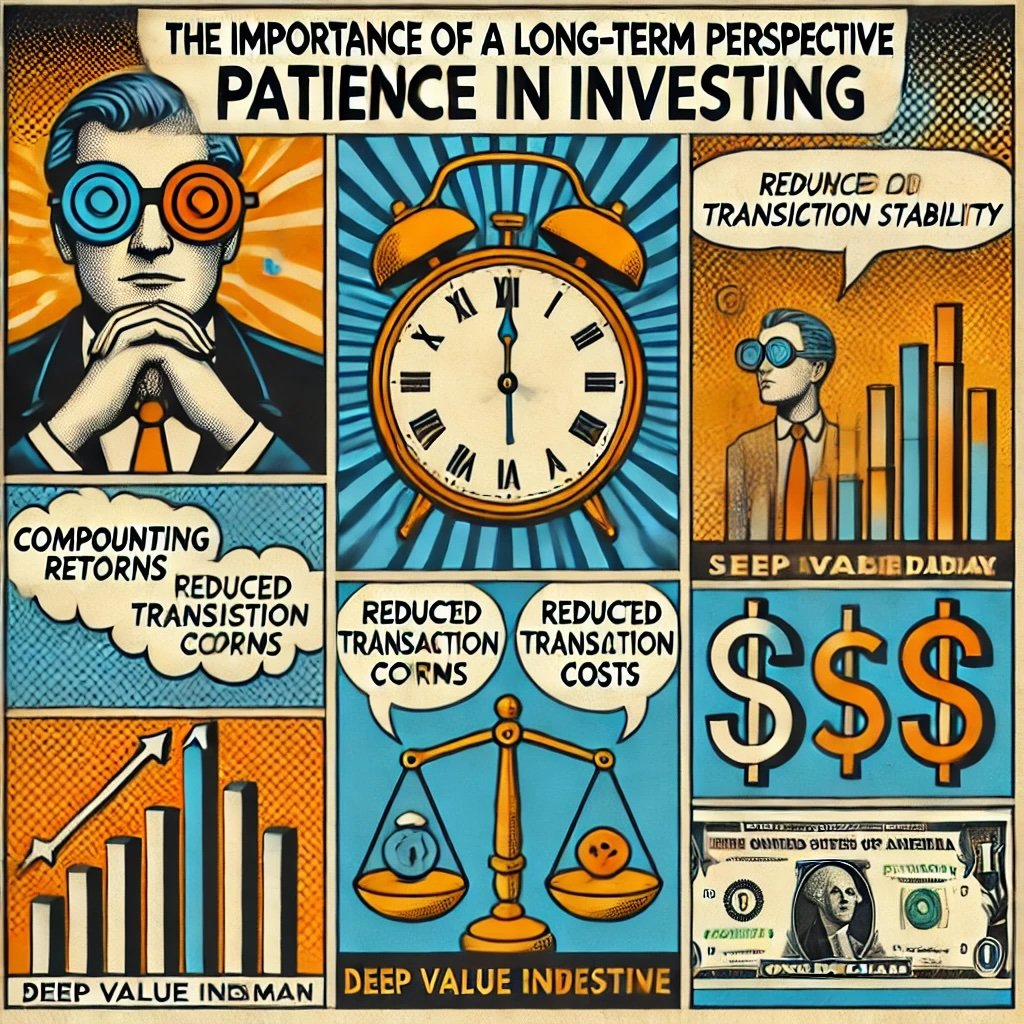
The Importance of a Long-Term Perspective
Patience in Investing: Letting Value Unfold
In the whirlwind world of investing, where headlines flash about overnight successes and sudden market dips, Seth Klarman stands as a testament to the power of patience. Klarman’s approach emphasizes holding investments for the long term, allowing intrinsic value to be realized fully. This steadfast commitment to long-term investing is not just a strategy; it’s a philosophy that underpins his remarkable success in deep value investing.
Patience, in Klarman’s eyes, is more than a passive waiting game. It’s an active commitment to understanding that true value often takes time to materialize. By holding onto investments through market cycles, Klarman ensures that his portfolio benefits from the compound growth of high-quality assets. This approach minimizes the impact of short-term volatility and maximizes the potential for substantial returns over time.
Why Patience Matters:
- Compounding Returns: Allowing investments to grow and reinvest earnings can lead to exponential growth.
- Reduced Transaction Costs: Fewer trades mean lower fees and taxes, preserving more of your returns.
- Emotional Stability: Patience helps investors avoid panic selling during market downturns, maintaining a steady course.
Klarman’s patience is rooted in thorough research and a deep understanding of the businesses he invests in. By focusing on companies with strong fundamentals and long-term growth potential, he trusts that the market will eventually recognize their true value. This disciplined patience is a cornerstone of his investment philosophy, enabling him to stay the course even when others falter.
Tip for Best Practices: Cultivate patience by setting clear long-term goals and reminding yourself that building wealth takes time. Resist the urge to react impulsively to short-term market movements and stay focused on your investment thesis.

Ignoring Short-Term Market Noise: Staying Focused Amid Fluctuations
While patience is essential, equally important is the ability to ignore short-term market noise. In today’s fast-paced financial environment, investors are bombarded with constant updates, news flashes, and market rumors. Seth Klarman masterfully navigates this chaos by maintaining a clear focus on his long-term investment strategy, undeterred by the daily fluctuations that often lead to emotional decision-making.
Klarman understands that short-term market movements are influenced by a myriad of factors, many of which are transient and unrelated to a company’s fundamental value. By filtering out this noise, he ensures that his investment decisions are based on solid analysis rather than reactionary impulses. This disciplined approach prevents him from making hasty decisions that could jeopardize his long-term investment goals.
Strategies to Ignore Market Noise:
- Stick to Your Plan: Adhere to your investment strategy regardless of daily market movements.
- Focus on Fundamentals: Base your decisions on thorough research and the intrinsic value of investments.
- Limit Information Overload: Selectively consume information that directly impacts your investment decisions.
Klarman’s ability to remain calm and rational during market turmoil is a key factor in his success. By focusing on the underlying value of his investments and disregarding the incessant chatter of the markets, he maintains a clear vision and makes informed decisions that align with his long-term objectives.
Bold Move: Challenge yourself to disconnect from daily market updates. Instead, allocate specific times to review your investments and make decisions based on comprehensive analysis rather than fleeting news.
Tip for Best Practices: Implement a routine that includes periodic portfolio reviews rather than reacting to every market dip or surge. This helps maintain focus on your long-term strategy and reduces the influence of short-term noise.
Example: Klarman’s Investment in Fixed-Income Securities
A quintessential example of Seth Klarman’s long-term perspective is his investment in fixed-income securities during periods when they were out of favor. In the early 2000s, interest rates were fluctuating, and the bond market was experiencing volatility. While many investors shied away from fixed-income assets, fearing further rate hikes and economic uncertainty, Klarman saw an opportunity.
The Investment Decision:
- Market Conditions: High volatility in the bond market with uncertain economic prospects.
- Klarman’s Analysis: Despite the market’s pessimism, Klarman identified fixed-income securities that were trading below their intrinsic value due to temporary market fears.
- Action Taken: He invested heavily in these undervalued bonds, maintaining his position through market fluctuations.
Outcome:
Over the years, as the market stabilized and interest rates became more predictable, the value of these fixed-income securities appreciated significantly. Klarman’s patience allowed him to benefit from the eventual market recognition of their true value, resulting in substantial returns for the Baupost Group.
Lessons from the Case Study:
- Identify Undervalued Assets: Even in distressed markets, there are opportunities for deep value investments.
- Maintain Long-Term Commitment: Holding through volatility can lead to significant gains when the market corrects.
- Trust Your Analysis: Confidence in your research and investment thesis is crucial for enduring market challenges.
Tip for Best Practices: When considering an investment, evaluate whether the asset is undervalued based on thorough analysis. If so, have the patience to hold it through market cycles to realize its full potential.
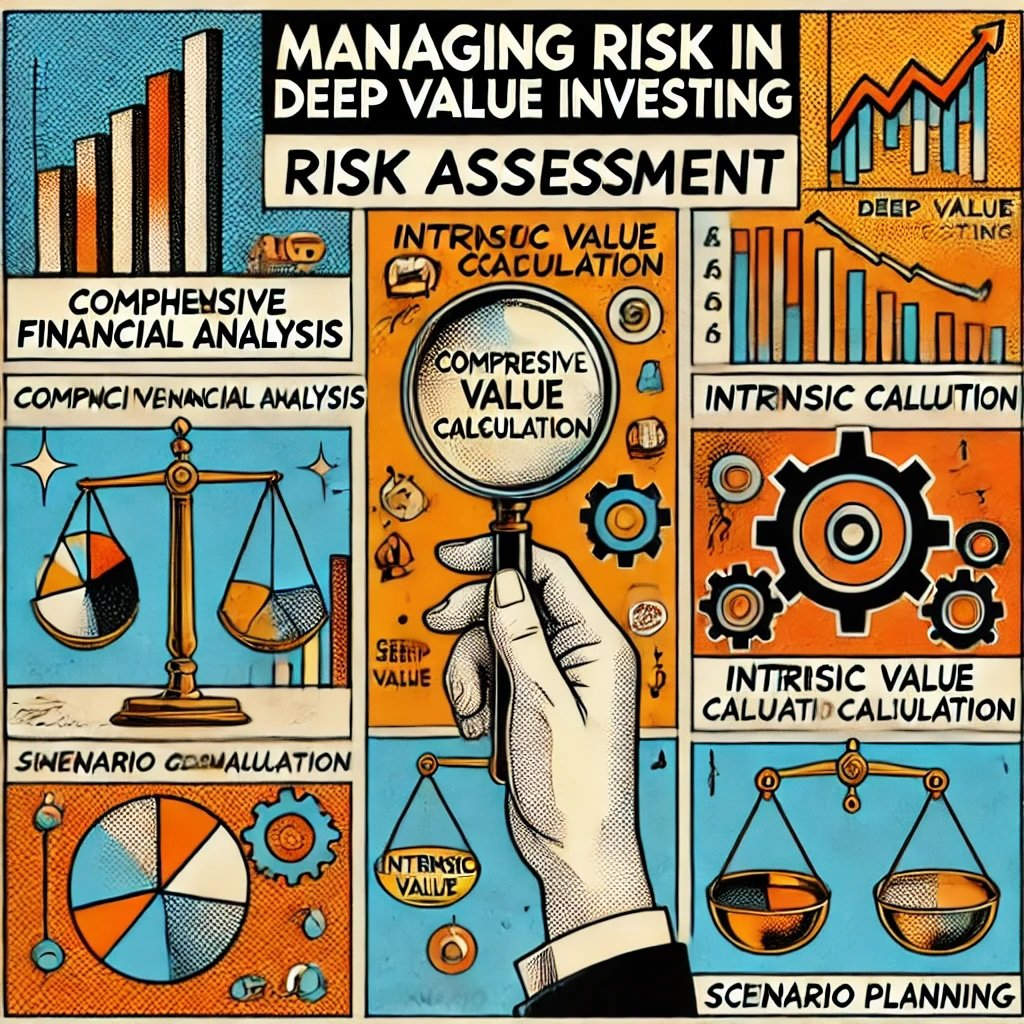
Managing Risk in Deep Value Investing
Risk Assessment: Navigating the Depths of Distressed Assets
Investing in distressed or out-of-favor assets can be both lucrative and perilous. Seth Klarman understands that with higher potential returns comes increased risk. His approach to risk assessment is meticulous, ensuring that each investment aligns with his deep value principles while safeguarding against significant downside.
How Klarman Assesses Risk:
- Comprehensive Financial Analysis: Klarman dives deep into financial statements to evaluate a company’s stability. He scrutinizes metrics like debt levels, cash flow, and profitability to ensure the company can weather economic storms.
- Intrinsic Value Calculation: By determining the intrinsic value of an asset, Klarman identifies how much safety margin exists. This calculation helps him understand the cushion available if the investment doesn’t perform as expected.
- Market Conditions Evaluation: Klarman assesses the broader economic and market conditions that could impact his investments. This includes understanding industry trends, regulatory changes, and macroeconomic factors that could influence asset performance.
- Scenario Planning: Klarman conducts scenario analyses to foresee potential adverse outcomes. By anticipating different market conditions, he prepares strategies to mitigate risks effectively.
Tip for Best Practices: Always perform a thorough risk assessment before investing in undervalued assets. Understanding the potential downsides is crucial for making informed investment decisions.
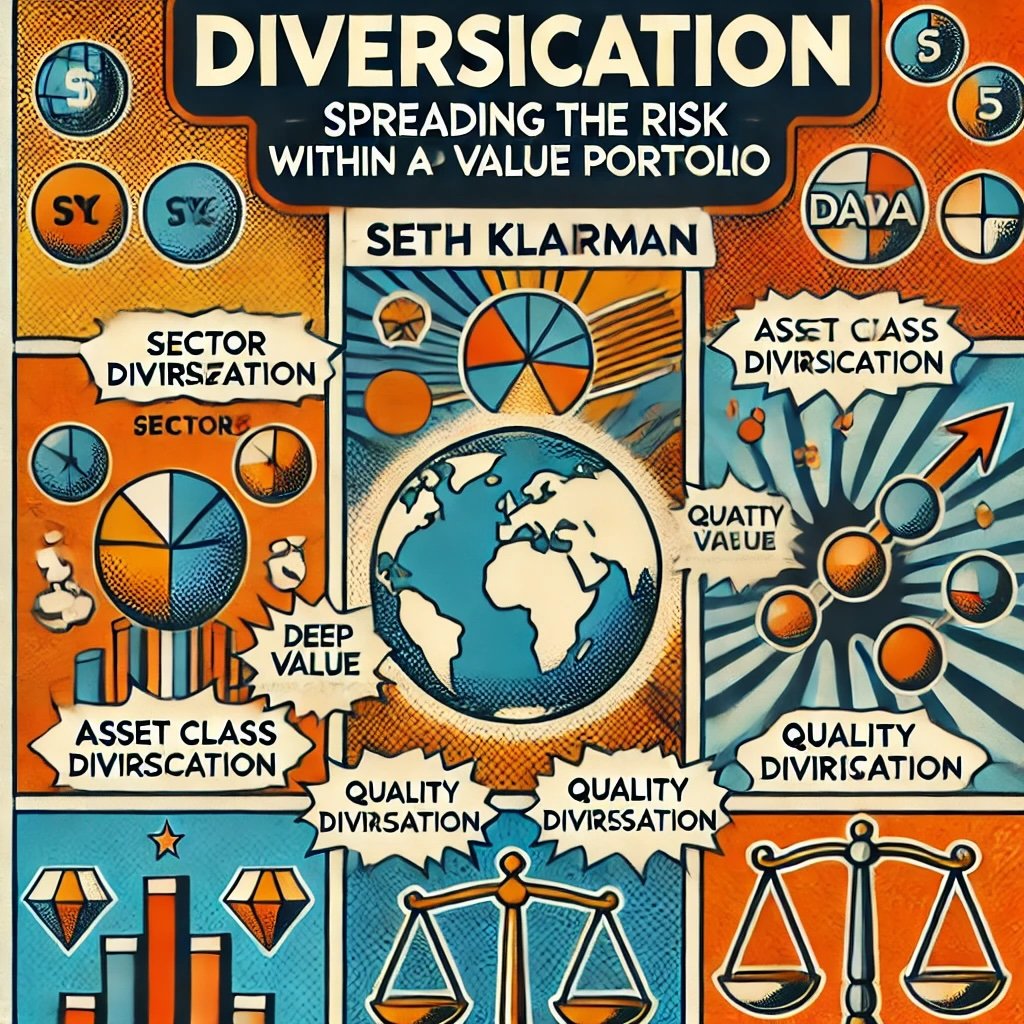
Diversification: Spreading the Risk Within a Deep Value Portfolio
While deep value investing often involves concentrated positions in high-conviction stocks, diversification remains a key component in risk management. Klarman leverages diversification to mitigate risks without diluting the core strength of his portfolio.
The Role of Diversification in Deep Value Investing:
- Sector Diversification: By spreading investments across various industries, Klarman reduces the impact of sector-specific downturns. For example, investing in both healthcare and manufacturing ensures that poor performance in one sector doesn’t cripple the entire portfolio.
- Geographical Diversification: Klarman invests in companies from different geographic regions. This approach protects against regional economic downturns and takes advantage of growth opportunities in emerging markets.
- Asset Class Diversification: Beyond equities, Klarman includes other asset classes such as bonds, real estate, and distressed securities. This mix balances the portfolio, providing stability through fixed-income investments while maintaining growth potential.
- Quality Diversification: Even within a concentrated portfolio, Klarman ensures that each holding meets his high-quality criteria. This means investing in companies with strong fundamentals, robust cash flows, and competent management teams.
Tip for Best Practices: Diversify your deep value portfolio across different sectors, geographies, and asset classes to spread risk effectively while maintaining investment quality.
Example: Balancing Risk in Klarman’s Deep Value Portfolio
To illustrate how Seth Klarman balances risk in a deep value portfolio, let’s examine a case study of his investment in Caterpillar Inc. during a period when the construction and mining industries were facing significant challenges.
The Context:
In the late 1990s, Caterpillar Inc. was grappling with declining demand in the construction and mining sectors. The company’s stock was trading at a substantial discount due to pessimistic market sentiment about the industry’s future. Despite these challenges, Klarman saw an opportunity.
Klarman’s Risk Management Approach:
- Thorough Due Diligence: Klarman conducted an in-depth analysis of Caterpillar’s financials, examining its balance sheet, cash flow, and debt levels. He determined that the company had a strong cash position and manageable debt, even amidst declining revenues.
- Assessing Management Quality: Klarman evaluated the leadership team’s ability to navigate the company through tough times. He found that Caterpillar’s management was proactive in cost-cutting measures and strategic in diversifying their product offerings.
- Margin of Safety: By purchasing Caterpillar’s stock at a significant discount to its intrinsic value, Klarman ensured a robust margin of safety. This discount provided a cushion against further declines and potential missteps in the company’s turnaround efforts.
- Diversification Within the Investment: While holding a concentrated position in Caterpillar, Klarman balanced his overall portfolio with investments in other undervalued sectors such as distressed real estate and undervalued financial stocks. This diversification helped offset risks specific to the heavy machinery industry.
Outcome:
Over the next few years, as the global economy stabilized and demand in construction and mining rebounded, Caterpillar’s stock price appreciated significantly. Klarman’s investment not only yielded substantial returns but also demonstrated the effectiveness of his risk management strategies in deep value investing.
Lessons from the Case Study:
- Thorough Research Pays Off: Comprehensive analysis reduces uncertainty and builds confidence in investment decisions.
- Diversification Mitigates Risk: Balancing concentrated investments with diversified holdings can protect against sector-specific downturns.
- Margin of Safety is Essential: Buying with a margin of safety provides a buffer that enhances investment resilience.
Tip for Best Practices: When investing in distressed assets, ensure that each investment is supported by thorough research and is part of a diversified portfolio to manage overall risk effectively.
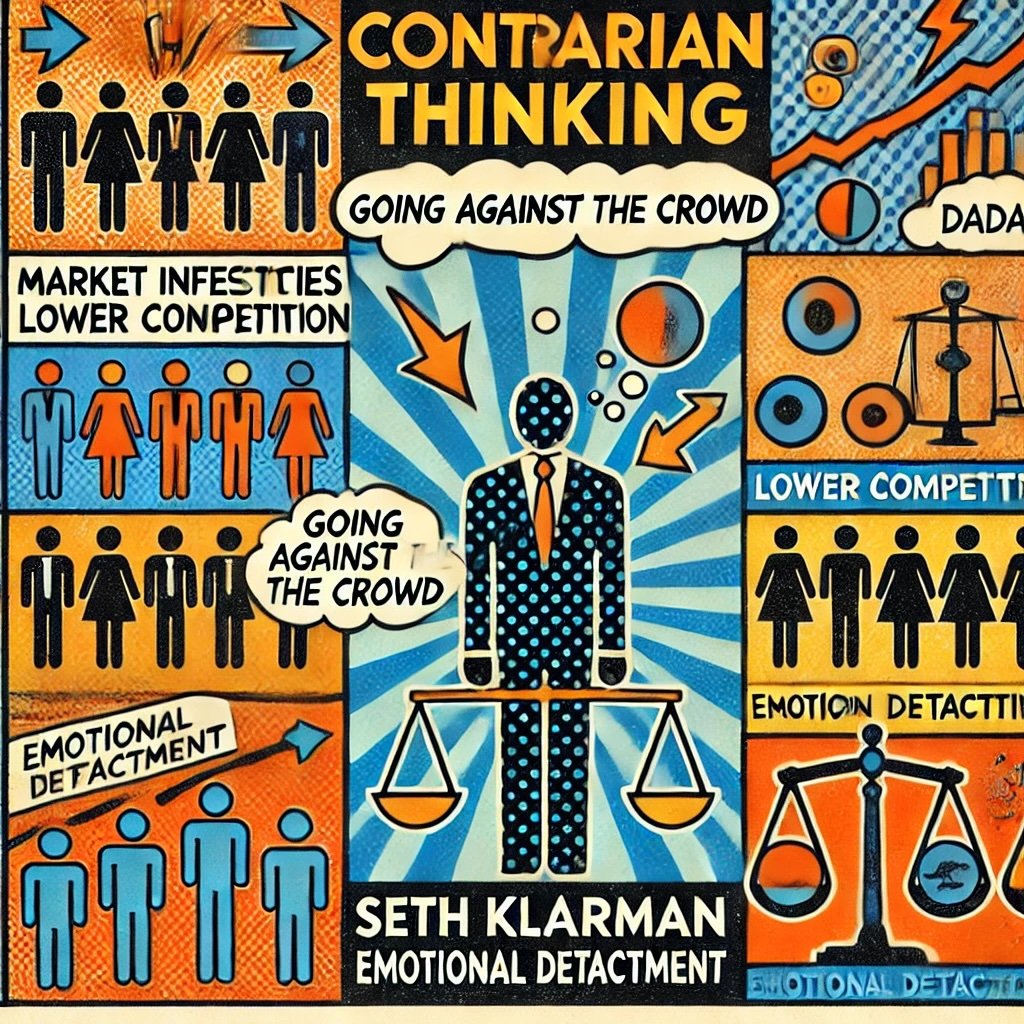
Contrarian Thinking
Going Against the Crowd: Embracing the Unpopular
In the investment world, following the crowd is often seen as a safe bet. However, Seth Klarman thrives on the opposite strategy—contrarian thinking. This approach involves investing in assets that others are avoiding, finding value where the majority sees risk or decline. Klarman’s ability to go against the grain has been a key driver of his success, allowing him to uncover hidden gems in overlooked or distressed markets.
Why Contrarian Thinking Works:
- Market Inefficiencies: The market doesn’t always price assets accurately. By identifying and capitalizing on these inefficiencies, contrarian investors can gain substantial returns.
- Lower Competition: When everyone is flocking to popular stocks, those willing to invest in less favored assets face less competition, often securing better prices.
- Emotional Detachment: Contrarians remain unemotional about investments, focusing on fundamentals rather than market sentiment.
Klarman’s contrarian approach isn’t about being contrarian for the sake of it. It’s a disciplined strategy rooted in deep analysis and a thorough understanding of the intrinsic value of assets. By identifying opportunities where others see trouble, he positions himself to benefit when the market eventually corrects its misconceptions.
Tip for Best Practices: Develop a strong conviction in your investment thesis. Contrarian investing requires confidence in your analysis and the patience to wait for the market to recognize the true value of your investments.
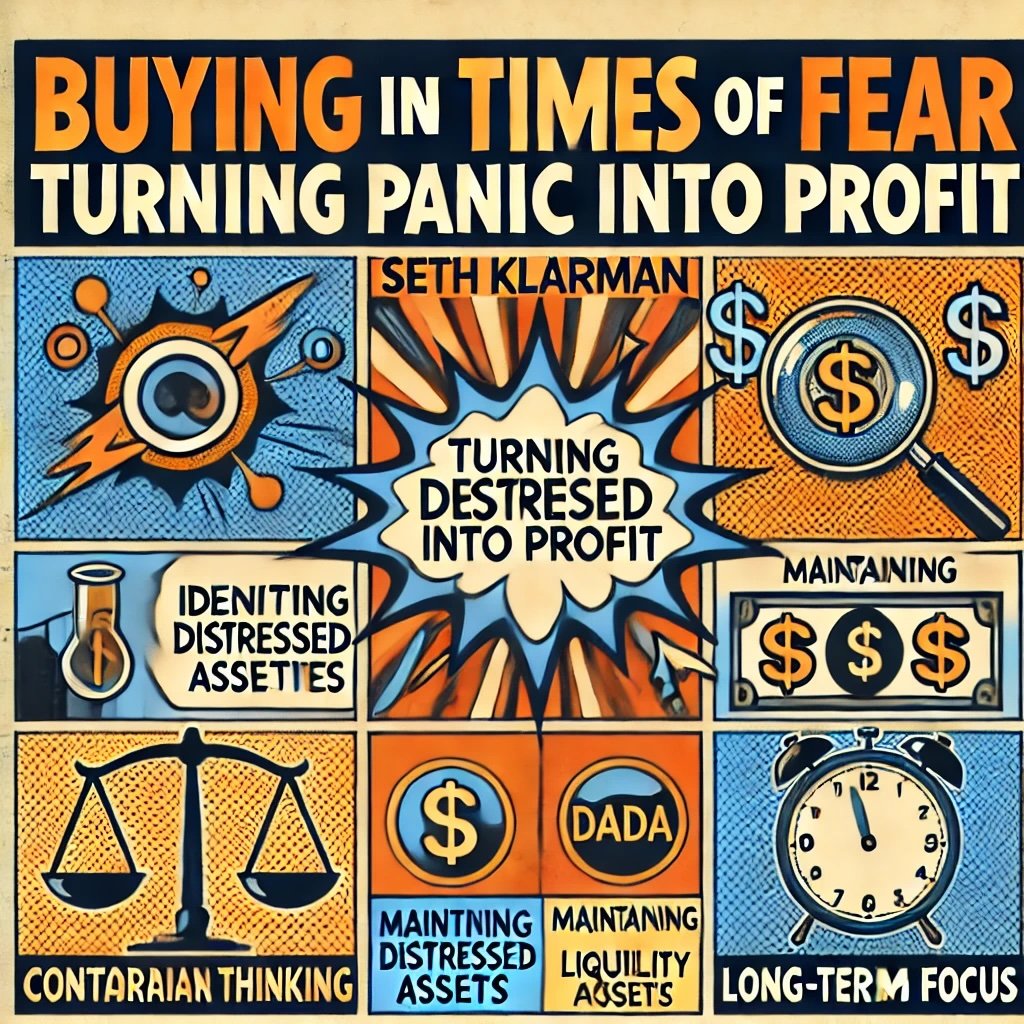
Buying in Times of Fear: Turning Panic into Profit
One of the most powerful aspects of contrarian thinking is the ability to capitalize on market fear. During periods of widespread pessimism, prices of quality assets often plummet, presenting unique buying opportunities. Klarman excels in these scenarios, using market downturns as chances to acquire undervalued assets at bargain prices.
How Klarman Buys in Times of Fear:
- Identifying Distressed Assets: He looks for companies with solid fundamentals that are temporarily undervalued due to market overreactions.
- Maintaining Liquidity: Klarman ensures that his portfolio has sufficient cash reserves to seize opportunities when fear grips the market.
- Long-Term Focus: By focusing on long-term potential, Klarman remains steadfast, buying assets that he believes will recover and thrive once the market stabilizes.
Benefits of Buying in Fear:
- Enhanced Returns: Purchasing assets at depressed prices can lead to significant gains as the market corrects itself.
- Building a Strong Portfolio: Acquiring quality assets during downturns strengthens the overall quality and resilience of your portfolio.
- Psychological Advantage: Contrarians avoid the emotional pitfalls of panic selling and maintain a rational investment approach.
Klarman’s strategy during the 2008 financial crisis is a prime example of buying in times of fear. While many investors were selling off assets in a panic, Klarman identified opportunities in distressed securities that others deemed too risky. His disciplined approach allowed him to acquire high-quality investments at substantial discounts, positioning his portfolio for impressive recoveries as the market rebounded.
Bold Move: Don’t shy away from investing during market downturns. Instead, look for opportunities where fear has driven prices below their intrinsic value, providing a margin of safety for your investments.
Tip for Best Practices: Stay informed and vigilant during market downturns. Use these periods to reassess your portfolio, identify undervalued opportunities, and act decisively based on thorough research rather than market hysteria.
Example: Klarman’s Contrarian Investments During the Dot-Com Bust
A notable illustration of Seth Klarman’s contrarian approach is his investment during the dot-com bust of the early 2000s. As the technology sector faced massive sell-offs and valuations plummeted, Klarman identified opportunities where the market had overreacted to short-term challenges.
The Scenario:
During the peak of the dot-com bubble, technology stocks soared to unprecedented heights, driven by speculative investments and unrealistic growth projections. However, as the bubble burst, these stocks plummeted, causing widespread panic and significant losses for many investors.
Klarman’s Strategy:
- Identifying Undervalued Tech Stocks: Klarman focused on technology companies with strong fundamentals that were unfairly punished by the market’s irrational fears.
- Assessing Intrinsic Value: He meticulously analyzed the financial health, revenue streams, and long-term prospects of these companies to determine their true worth.
- Taking a Long-Term View: Klarman wasn’t swayed by the immediate downturn. He recognized that these companies had the potential to recover and thrive once market sentiments stabilized.
Outcome:
As the market eventually regained confidence in the technology sector, the stocks Klarman had invested in rebounded significantly. His contrarian bets not only minimized losses but also delivered impressive returns, validating his strategy of buying in times of fear.
Lessons from the Case Study:
- Market Overreactions Create Opportunities: Extreme fear can lead to mispriced assets, offering buying opportunities for disciplined investors.
- Thorough Analysis is Crucial: Deep understanding of an asset’s fundamentals ensures that investments are made with a strong margin of safety.
- Long-Term Perspective Pays Off: Patience and a commitment to long-term investing enable investors to ride out volatility and benefit from market recoveries.
Tip for Best Practices: When facing market downturns, focus on quality and fundamentals. Avoid getting swept up in the panic and instead, look for opportunities where sound companies are trading below their intrinsic value.
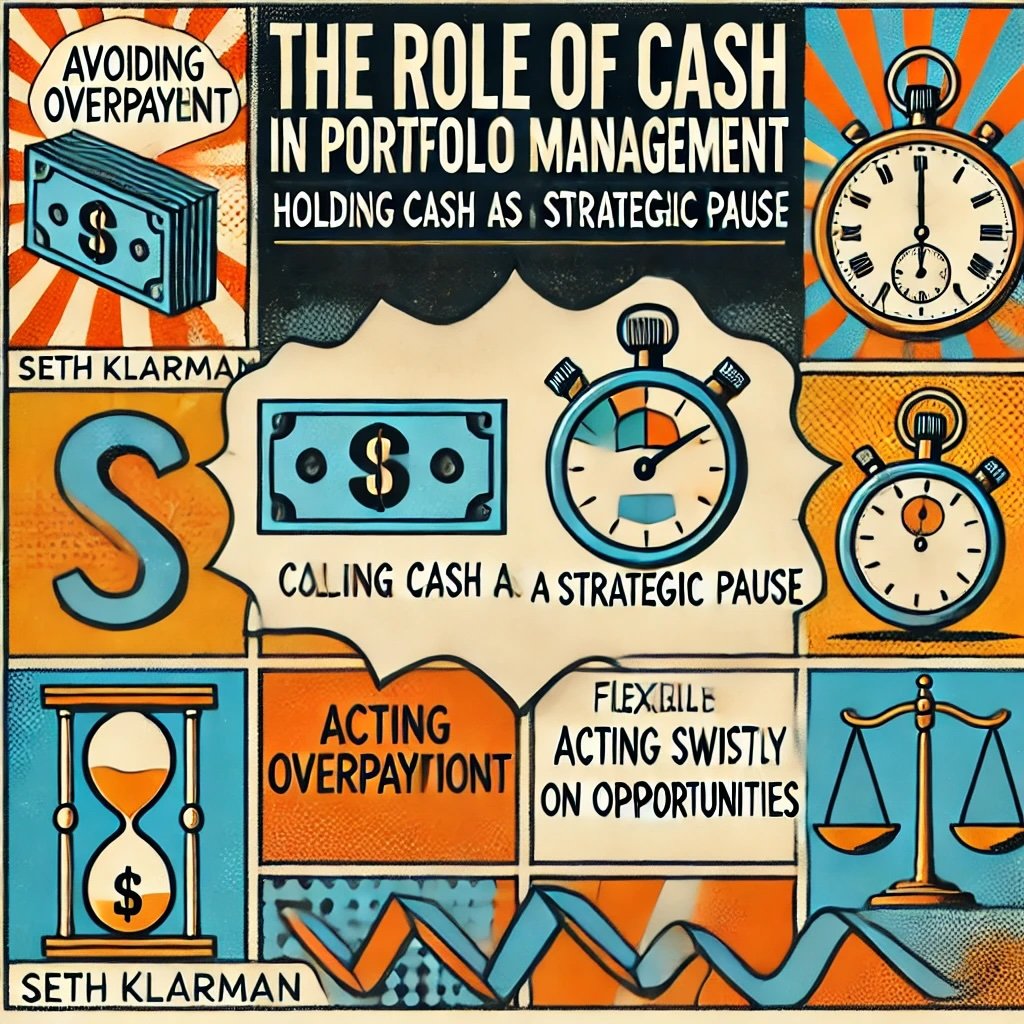
The Role of Cash in Portfolio Management
Holding Cash: The Strategic Pause
In the high-stakes game of investing, holding cash might seem counterintuitive, especially when markets are booming. However, Seth Klarman turns this notion on its head, viewing cash not as idle money but as a strategic asset. Klarman’s approach involves holding cash when value opportunities are scarce, ensuring that he doesn’t overpay for investments that don’t meet his rigorous criteria. This disciplined stance allows him to maintain flexibility and seize exceptional opportunities when they arise.
Why Holding Cash is Crucial:
- Avoiding Overpayment: In bullish markets, asset prices can soar beyond their intrinsic value. By holding cash, Klarman avoids the temptation to buy into overpriced scenarios, preserving capital for better opportunities.
- Flexibility: Cash reserves provide the agility to act swiftly when undervalued assets emerge. This readiness is essential in deep value investing, where timing can significantly impact returns.
- Risk Mitigation: Holding cash reduces portfolio risk by maintaining a buffer against market downturns. It provides peace of mind and stability, allowing Klarman to stay committed to his long-term strategy without the pressure to sell at inopportune times.
Klarman’s disciplined approach to holding cash ensures that he remains prepared for market dislocations. Instead of chasing every investment, he patiently waits for the right moment to deploy his capital, ensuring each investment aligns with his deep value principles.
Tip for Best Practices: Maintain a healthy cash reserve in your portfolio. This reserve acts as a safety net and provides the means to capitalize on undervalued opportunities when they emerge.
Deploying Cash Strategically: Seizing Market Dislocations
While holding cash is essential, deploying it strategically is where Klarman’s expertise truly shines. When market conditions create dislocations—such as panic selling, economic downturns, or sector-specific crises—Klarman leverages his cash reserves to acquire high-quality assets at deeply discounted prices.
How Klarman Deploys Cash Strategically:
- Identifying Mispriced Assets: Klarman continuously monitors the market for assets that are trading below their intrinsic value due to temporary setbacks or widespread pessimism.
- Quick Decision-Making: With cash on hand, Klarman can swiftly act on investment opportunities without the delays associated with raising new capital or liquidating other positions.
- Maintaining Discipline: Klarman’s strategy involves sticking to his investment criteria even in turbulent times. This discipline ensures that he invests only in assets that meet his stringent standards, preventing impulsive or speculative bets.
- Rebalancing the Portfolio: During market dislocations, Klarman reassesses his portfolio and makes adjustments to maintain optimal risk and return profiles. This might involve increasing positions in undervalued assets or divesting from overvalued ones.
By strategically deploying cash, Klarman ensures that his portfolio is positioned to benefit from market inefficiencies. This approach not only enhances potential returns but also reinforces the overall resilience of the portfolio.
Bold Move: Embrace the power of cash. It’s not just idle money—it’s a dynamic resource that can drive substantial gains when deployed intelligently.
Tip for Best Practices: Regularly assess market conditions and be ready to act when opportunities arise. Having a clear plan for deploying cash can help you stay disciplined and take advantage of deep value opportunities effectively.
Example: Klarman’s Capitalization During the 2008 Financial Crisis
A prime illustration of Klarman’s effective use of cash reserves is his investment strategy during the 2008 financial crisis. While many investors panicked and sold off their holdings, Klarman remained calm and strategic, using his cash reserves to seize undervalued opportunities.
The Situation:
- Market Turmoil: The 2008 crisis led to significant declines across various asset classes, driven by fears of a widespread economic collapse.
- Distressed Assets: Numerous high-quality companies found themselves trading at steep discounts due to market panic and uncertainty.
- Opportunity Awaits: Klarman identified several such companies whose fundamentals remained strong despite the market’s irrational fear.
Klarman’s Actions:
- Purchasing Distressed Securities: He invested heavily in distressed bonds and stocks that were trading below their intrinsic value, confident that the market would eventually recognize their true worth.
- Maintaining a Long-Term View: Klarman didn’t get swayed by the immediate downturn. He held onto his investments, allowing the companies to stabilize and grow as the market recovered.
- Reaping the Rewards: As the market rebounded, the value of these investments surged, resulting in substantial returns for the Baupost Group.
Outcome:
- Significant Gains: Klarman’s strategic deployment of cash during the crisis not only preserved capital but also delivered impressive returns as the market stabilized and the prices of distressed assets recovered.
- Reinforced Strategy: This successful maneuver reinforced the effectiveness of Klarman’s approach, showcasing how holding and deploying cash strategically can lead to exceptional outcomes during market dislocations.
Lessons from the Case Study:
- Stay Calm in Crisis: Emotional control is crucial during market downturns. Maintain your composure and stick to your investment principles.
- Identify True Value: Focus on the fundamentals and intrinsic value, rather than getting caught up in market panic.
- Use Cash Wisely: Having cash reserves allows you to act decisively and capitalize on opportunities that others may miss.
Tip for Best Practices: During market downturns, assess the quality and intrinsic value of potential investments rather than succumbing to fear. Use your cash reserves to invest in assets that meet your deep value criteria, positioning your portfolio for long-term growth.
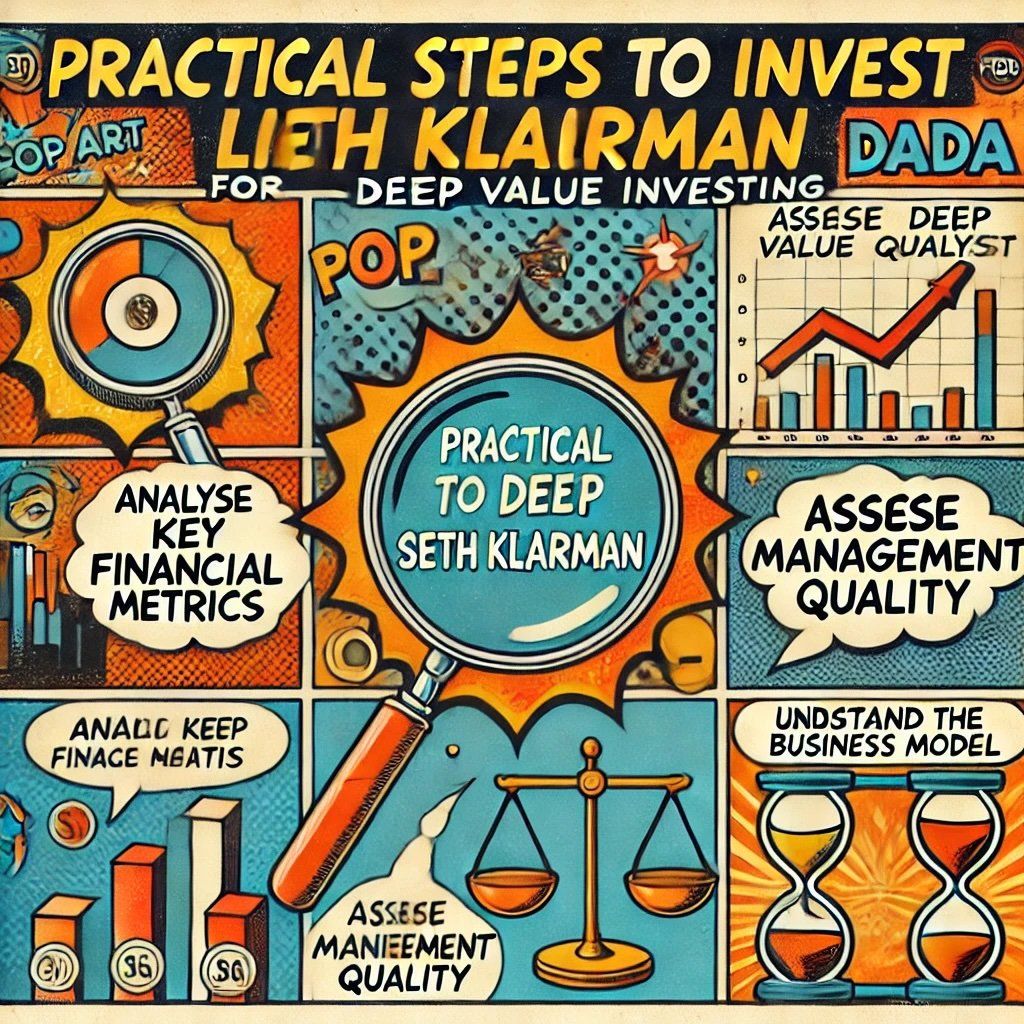
Practical Steps to Invest Like Seth Klarman
Research and Analysis: Laying the Groundwork for Deep Value
Emulating Seth Klarman’s deep value investing strategy starts with thorough research and analysis. Klarman’s success is rooted in his ability to dig deep into both quantitative and qualitative aspects of potential investments. Here’s how you can adopt his meticulous approach to uncover deep value opportunities:
1. Conduct Comprehensive Financial Analysis
Begin by diving into a company’s financial statements. Klarman scrutinizes every detail to assess the true financial health of a business.
- Analyze Key Financial Metrics:
- Price-to-Book (P/B) Ratio: Look for companies trading below their book value.
- Price-to-Earnings (P/E) Ratio: Identify stocks with low P/E ratios compared to industry peers.
- Cash Flow Analysis: Focus on companies with strong free cash flow, indicating financial stability.
- Evaluate Financial Health:
- Revenue Growth: Consistent growth suggests a sustainable business model.
- Profit Margins: Healthy margins indicate operational efficiency.
- Debt Levels: Companies with manageable debt are less vulnerable to economic downturns.
2. Perform Qualitative Assessments
Numbers alone don’t tell the whole story. Klarman places significant emphasis on understanding the qualitative aspects of a company.
- Assess Management Quality:
- Track Record: Evaluate the leadership’s history of making sound decisions.
- Vision and Strategy: Ensure the management has a clear and achievable plan for growth.
- Integrity: Look for transparency and ethical practices in management.
- Understand the Business Model:
- Sustainability: Analyze whether the company’s business model can adapt to changing market conditions.
- Competitive Advantages: Identify unique strengths such as patents, brand loyalty, or cost leadership.
- Evaluate Market Position:
- Market Share: Companies with significant market share often have more pricing power.
- Industry Trends: Stay informed about the broader industry dynamics that could impact the company’s performance.
Tip for Best Practices: Combine both quantitative and qualitative analyses to gain a holistic view of potential investments. This balanced approach ensures you’re not overlooking any critical factors that could influence a company’s long-term success.
Building a Deep Value Portfolio: Crafting Your Investment Blueprint
Once you’ve identified deep value opportunities through diligent research, the next step is constructing a portfolio that aligns with Klarman’s principles. Here are some tips to help you build a robust deep value portfolio:
1. Focus on Quality Over Quantity
Klarman believes in holding a concentrated portfolio of high-conviction stocks rather than spreading investments thinly across numerous assets.
- Select High-Quality Companies: Prioritize businesses with strong fundamentals, competitive advantages, and capable management.
- Limit Your Holdings: Aim for a manageable number of investments, typically between 10-20 stocks, to maintain focus and oversight.
2. Ensure Diversification Within Deep Value
While concentration is key, diversification remains essential to mitigate risk.
- Diversify Across Industries: Spread your investments across different sectors to avoid sector-specific downturns impacting your entire portfolio.
- Geographical Diversification: Invest in companies from various regions to protect against regional economic fluctuations.
3. Maintain a Margin of Safety
Always invest with a significant margin of safety to protect against potential losses.
- Buy Below Intrinsic Value: Ensure that each investment is purchased at a price well below its calculated intrinsic value.
- Reevaluate Regularly: Continuously assess the intrinsic value of your holdings to confirm they still offer a sufficient margin of safety.
4. Allocate Appropriately
Balance your portfolio by allocating funds based on the strength of your investment thesis for each stock.
- Higher Allocation for Stronger Convictions: Allocate more capital to stocks where your research indicates a higher probability of success.
- Reserve Capital for New Opportunities: Keep some funds in reserve to capitalize on new deep value opportunities as they arise.
Tip for Best Practices: Regularly review and rebalance your portfolio to ensure it remains aligned with your deep value investing strategy. This proactive management helps maintain the quality and resilience of your investments.
Staying Disciplined: Upholding Klarman’s Investment Principles
Discipline is the backbone of Seth Klarman’s deep value investing strategy. Maintaining discipline ensures that you stick to your investment principles, even when faced with market exuberance or panic. Here’s how to cultivate and maintain this crucial trait:
1. Develop a Clear Investment Thesis
Before making any investment, define your rationale clearly.
- Outline Your Criteria: Establish specific criteria for what constitutes a deep value investment, including financial metrics and qualitative factors.
- Document Your Reasons: Keep a record of why you believe a particular stock is undervalued and how it meets your investment criteria.
2. Avoid Emotional Decision-Making
Emotions can cloud judgment and lead to impulsive decisions. Klarman emphasizes the importance of staying rational.
- Stick to Your Plan: Follow your investment strategy consistently, regardless of market sentiment.
- Resist the Herd Mentality: Don’t be swayed by what everyone else is doing. Trust your research and analysis instead.
3. Be Patient and Long-Term Focused
Deep value investing requires time to realize its full potential.
- Hold Investments Long-Term: Allow your investments the time needed to recover and grow as the market recognizes their true value.
- Ignore Short-Term Fluctuations: Focus on the long-term prospects of your investments rather than getting distracted by daily price movements.
4. Continuously Educate Yourself
Stay informed and continually refine your investment approach.
- Read Widely: Stay updated with financial news, investment books, and Klarman’s writings.
- Learn from Mistakes: Analyze your investment decisions to understand what worked and what didn’t, and adjust your strategy accordingly.
Tip for Best Practices: Create a disciplined investment routine that includes regular portfolio reviews, adherence to your investment criteria, and ongoing education. This routine helps reinforce your commitment to deep value investing principles.
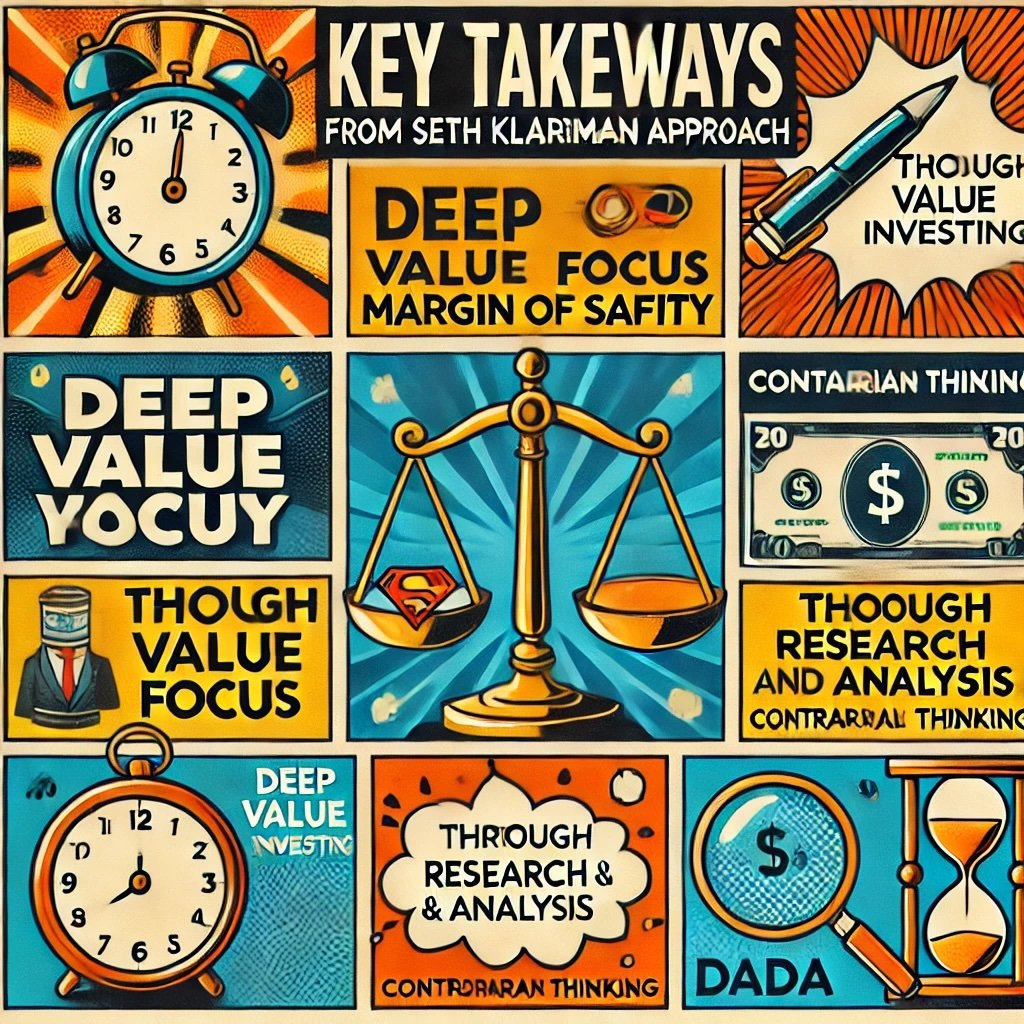
Key Takeaways from Seth Klarman’s Deep Value Investing Approach
As we wrap up our deep dive into Seth Klarman’s deep value investing strategy, it’s clear that his methodology is both robust and timeless. Klarman’s approach is a masterclass in disciplined investing, emphasizing the importance of finding undervalued assets and maintaining a strong margin of safety. Let’s recap the key takeaways from his investment philosophy:
- Deep Value Focus: Klarman targets assets that are significantly undervalued, ensuring a substantial discount to their intrinsic value.
- Margin of Safety: By purchasing investments well below their calculated intrinsic value, Klarman protects against downside risks and enhances potential returns.
- Thorough Research and Analysis: Combining both quantitative and qualitative analyses, Klarman ensures that each investment is backed by solid fundamentals and a comprehensive understanding of the company.
- Contrarian Thinking: Embracing a contrarian mindset allows Klarman to invest in assets that others are avoiding, capitalizing on market inefficiencies.
- Long-Term Perspective: Patience is paramount. Klarman holds investments for the long term, allowing intrinsic value to be realized without being swayed by short-term market fluctuations.
- Risk Management through Diversification: While maintaining a concentrated portfolio, Klarman diversifies across industries and asset classes to mitigate risks.
- Strategic Cash Management: Holding cash reserves provides the flexibility to seize opportunities during market dislocations, ensuring readiness without overcommitting during times of scarcity.
The Pillars of Successful Value Investing: Patience, Discipline, and Contrarian Thinking
Patience, discipline, and contrarian thinking are the cornerstones of Seth Klarman’s investing success. These pillars not only define his approach but also offer valuable lessons for investors aiming to build resilient and profitable portfolios.
Patience
Patience allows investors to wait for the right opportunities and give their investments the time needed to grow. Klarman’s long-term commitment ensures that his investments mature and compound, maximizing returns while minimizing the stress of short-term volatility.
- Stay Committed: Trust in your investment thesis and give your investments the time they need to realize their full potential.
- Avoid Impulsive Decisions: Resist the urge to react to every market dip or surge. Focus on the long-term value of your holdings.
Discipline
Discipline ensures that investors stick to their strategies, even when faced with market noise or emotional temptations. Klarman’s disciplined approach prevents him from deviating from his investment principles, ensuring consistent and rational decision-making.
- Stick to Your Plan: Develop a clear investment strategy and adhere to it, regardless of market sentiments.
- Maintain Emotional Control: Keep emotions in check to make objective investment decisions based on thorough analysis.
Contrarian Thinking
Contrarian thinking empowers investors to seek opportunities where others see risk or decline. Klarman’s ability to go against the crowd allows him to uncover hidden value and capitalize on market inefficiencies.
- Embrace the Unpopular: Don’t shy away from investing in assets that are out of favor. Look for opportunities where the market has mispriced an asset.
- Leverage Market Fear: Use periods of widespread pessimism to acquire quality assets at discounted prices, enhancing your portfolio’s potential for substantial returns.
Applying Klarman’s Strategies to Your Own Investing Practices
Adopting Seth Klarman’s deep value investing principles can transform your investment approach, leading to more informed and disciplined decision-making. Here’s how you can incorporate his strategies into your own portfolio:
1. Conduct Thorough Research and Analysis
- Quantitative Metrics: Utilize financial ratios like P/B, P/E, and cash flow analysis to identify undervalued stocks.
- Qualitative Factors: Assess management quality, business models, and competitive positioning to ensure long-term viability.
2. Build a High-Quality Deep Value Portfolio
- Focus on Quality: Prioritize investments in companies with strong fundamentals and sustainable competitive advantages.
- Diversify Wisely: Spread your investments across different sectors and asset classes to mitigate risks while maintaining a concentrated portfolio of high-conviction stocks.
- Maintain a Margin of Safety: Always invest with a significant discount to intrinsic value to protect against potential losses.
3. Stay Disciplined and Patient
- Long-Term Commitment: Hold investments for the long term, allowing them to grow and compound without being swayed by short-term market movements.
- Ignore Market Noise: Focus on your investment thesis and avoid reacting to daily market fluctuations or hype.
- Strategic Cash Management: Keep cash reserves to seize opportunities during market dislocations without overpaying for assets.
Tip for Best Practices: Start by implementing one or two of Klarman’s principles in your investment strategy. For instance, begin by focusing on thorough research and maintaining a margin of safety. As you become more comfortable, gradually incorporate additional principles like contrarian thinking and strategic cash management.
Seth Klarman Deep-Value Investing — 12-Question FAQ
Who is Seth Klarman and why do investors study him?
He’s the founder of Baupost Group and author of Margin of Safety. He’s known for disciplined deep-value investing, opportunistic buying in dislocations, rigorous downside protection, and patient, benchmark-agnostic compounding.
What is “deep value” in Klarman’s sense?
Buying securities at substantial discounts to conservatively estimated intrinsic value—often in unpopular, complex, or temporarily distressed corners of the market—so the margin of safety absorbs errors and shocks.
What exactly is the “margin of safety”?
It’s the gap between price and a cautious estimate of value. Larger gaps create room for mistakes, bad luck, or macro surprises. Klarman prefers opportunities with multiple ways to win and limited ways to lose.
How does Klarman estimate intrinsic value?
He picks the right yardstick for the asset: discount cash flows for steady generators, NAV/asset appraisals for asset-rich issuers, liquidation or sum-of-the-parts for breakups/reorgs, and scenario-weighted analyses when outcomes are uncertain.
Where does he typically find ideas?
In overlooked niches: distressed and reorg debt, spin-offs, liquidations, busted convertibles, asset plays (real estate, NOLs, hard assets), small caps with sparse coverage, and “orphaned” securities after index or mandate changes.
How does he think about risk versus volatility?
Risk is permanent capital loss, not price wiggle. He fights it with balance-sheet strength, priority in the capital stack, purchase price discipline, diversification by outcome, and insisting on identifiable catalysts where possible.
When does Klarman hold cash—and why so much at times?
When bargains are scarce. Cash is a strategic option: it prevents style drift, avoids overpaying late-cycle, and is dry powder for panics. Being fully invested isn’t a goal; attractive IRR is.
What role do catalysts play?
They’re welcome but not mandatory. Examples: asset sales, buybacks, debt tenders, spin-offs, plan confirmations, management changes. Catalysts pull forward value realization and reduce duration risk.
How does he avoid value traps?
He tests why something is cheap (temporary vs. structural), re-underwrites with base-rate data, demands balance-sheet resilience, watches governance/incentives, and sets clear kill-criteria when facts break the thesis.
What are common mistakes Klarman warns against?
Benchmark herding, stretching for ideas when none exist, averaging down blindly, confusing complexity for value, ignoring balance sheets, using leverage to “fix” low expected returns, and letting taxes drive decisions.
How would a Klarman-style checklist look?
Cheap on multiple measures (e.g., FCF/EV, P/B below tangible value), downside modeled first, strong asset coverage, credible management/incentives, simple thesis path, identifiable risks with mitigants, and a pre-committed sell/trim plan.
How can individual investors implement this approach?
Screen for wide discounts, do primary reading (10-Ks, notes, covenants), model conservative scenarios, size positions modestly, keep cash, journal theses/updates, and review quarterly with evidence-based adds/exits.
Important Information
Comprehensive Investment Disclaimer:
All content provided on this website (including but not limited to portfolio ideas, fund analyses, investment strategies, commentary on market conditions, and discussions regarding leverage) is strictly for educational, informational, and illustrative purposes only. The information does not constitute financial, investment, tax, accounting, or legal advice. Opinions, strategies, and ideas presented herein represent personal perspectives, are based on independent research and publicly available information, and do not necessarily reflect the views or official positions of any third-party organizations, institutions, or affiliates.
Investing in financial markets inherently carries substantial risks, including but not limited to market volatility, economic uncertainties, geopolitical developments, and liquidity risks. You must be fully aware that there is always the potential for partial or total loss of your principal investment. Additionally, the use of leverage or leveraged financial products significantly increases risk exposure by amplifying both potential gains and potential losses, and thus is not appropriate or advisable for all investors. Using leverage may result in losing more than your initial invested capital, incurring margin calls, experiencing substantial interest costs, or suffering severe financial distress.
Past performance indicators, including historical data, backtesting results, and hypothetical scenarios, should never be viewed as guarantees or reliable predictions of future performance. Any examples provided are purely hypothetical and intended only for illustration purposes. Performance benchmarks, such as market indexes mentioned on this site, are theoretical and are not directly investable. While diligent efforts are made to provide accurate and current information, “Picture Perfect Portfolios” does not warrant, represent, or guarantee the accuracy, completeness, or timeliness of any information provided. Errors, inaccuracies, or outdated information may exist.
Users of this website are strongly encouraged to independently verify all information, conduct comprehensive research and due diligence, and engage with qualified financial, investment, tax, or legal professionals before making any investment or financial decisions. The responsibility for making informed investment decisions rests entirely with the individual. “Picture Perfect Portfolios” explicitly disclaims all liability for any direct, indirect, incidental, special, consequential, or other losses or damages incurred, financial or otherwise, arising out of reliance upon, or use of, any content or information presented on this website.
By accessing, reading, and utilizing the content on this website, you expressly acknowledge, understand, accept, and agree to abide by these terms and conditions. Please consult the full and detailed disclaimer available elsewhere on this website for further clarification and additional important disclosures. Read the complete disclaimer here.




